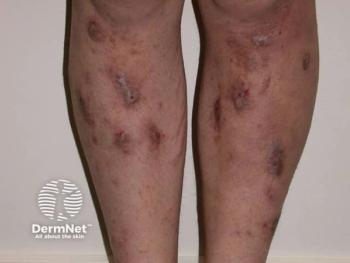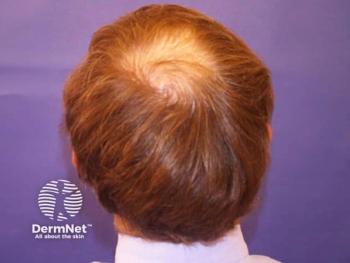
Study Finds Successful Switching Strategy for Patients with Psoriasis After Suboptimal Response
What can you do when a medication for psoriasis yields a suboptimal response? New data presented at the 2023 AAD Annual Meeting provides valuable insight on next steps for treatment.
New data presented during a late-breaking research session at the
To determine the next best course of action for patients, Richard Warren, MBChB (Hons), MRCP, PhD, professor of dermatology and therapeutics and Honorary Consultant Dermatologist from the University of Manchester and Norten Care Alliance, United Kingdom, and colleagues conducted an open-label, single-arm study of moderate to severe plaque psoriasis following suboptimal response from a minimum of 6 months of treatment with secukinumab or ixekizumab (AIMM Study
The phase 3b study included 252 participants with a median age of 50. About one-quarter (27.4%) of the participants were female, and the majority (88.1%) were white. The mean disease duration was 20.8 years. About half (40.5%) of patients enrolled had 2 or more prior biologic treatments, and all participants had been prescribed at least 1 prior biologic. More than half (62%) of the participants previously received secukinumab while 38% had received ixekizumab; the mean duration of previous treatment was 2.6 and 2.1 years for secukinumab and ixekizumab, respectfully. A minority of patients had a history of psoriatic arthritics (5.2%), and 1 patient had inflammatory bowel disease. The median PASI, BSA, DLQI, and PSS were 6.2, 6.0, 7.0, and 6.0, respectively.
Participants were enrolled and given risankizumab 150 mg once a week during weeks 0, 4, and 12 for 52 weeks without a washout period, Warren reported. “From my perspective, that reflects reasonably what we might do in clinic,” he told attendees.
At week 16, 56.3% of the original nonresponders had achieved sPGA 0/1, which was the primary endpoint. Furthermore, Warren said patients demonstrated numerical improvement from week 16 to week 52 on all endpoints (ie, achieving sPGA 0, DLQI 0/1, PSS 0 at weeks 16 and 52). Perhaps more importantly, the investigators found efficacy on all endoints were either maintained or continued to increase over time.
More than half of participants experienced at least 1 adverse event (AE), with COVID-19 (8.3%) and nasopharyngitis (5.6%) being the most common. There were 24 cases of severe AEs, and 21 cases of serious AE; 9 cases with AEs resulted in discontinuation of risankizumab. Warren noted the 2 participants with nonfatal myocardiac infarction had multiple cardiovascular risks. More importantly, he said there were no instances of active tuberculosis, opportunistic infections, serious hypersensitivity or adjudicated anaphylaxis, inflammatory bowel disease or death.
“In this difficult to treat population of psoriasis patients who showed a suboptimal response to IL-17 inhibitors (secukinumab or ixekizumab), switching directly to risankisumab led to reduced signs and symptoms of psoriasis and improve quality of life at weeks 16 and 52,” Warren told attendees. He added, “No new safety signals were observed when switching from secukinumab or ixekizumab to risankisumab without a washout period.”
Risankisumab, a humanized monoclonal antibody, selectively blocks interlueken-23 by binding to the p19 subunit; interlueken-23 has been associated with chronic immune-mediated disease and the inflammatory process. The medication is currently approved by the US Food and Drug Association to treat adults with: moderate to severe plaque psoriasis who may benefit from injections or pills or treatment using ultraviolet or UV light, active psoriatic arthritis, and moderate to severe Crohn's disease. Studies are underway looking at other potential indications.
"Advanced therapies represent an important option in the treatment of plaque psoriasis,” Warren said in a press statement, “but as a physician, it's critically important to continually assess if patients are having an optimal response to treatment, as residual psoriasis can still have a significant impact on a patient's life."2
Are you attending the AAD conference? Share your favorite clinical pearls or moments with us via email: DTEditor@mmhgroup.com.
References
1. Warren R. Efficacy and safety after 52 weeks in psoriasis patients switching to risankizumab after suboptimal response to secukinumab or ixekizumab. Late-breaking Research Session 1. 2023 American Academy of Dermatology Annual Meeting.
2. AbbVie Announces Late-Breaking Results of Study Evaluating 52-Week Efficacy and Safety of SKYRIZI® (risankizumab) in Plaque Psoriasis Patients With a Prior Suboptimal Response to IL-17 Inhibitor Therapy. March 18, 2023. Press release. Accessed March 19, 2023. https://news.abbvie.com/news/press-releases/abbvie-announces-late-breaking-results-study-evaluating-52-week-efficacy-and-safety-skyrizi-risankizumab-in-plaque-psoriasis-patients-with-prior-suboptimal-response-to-il-17-inhibitor-therapy.htm
Newsletter
Like what you’re reading? Subscribe to Dermatology Times for weekly updates on therapies, innovations, and real-world practice tips.


















